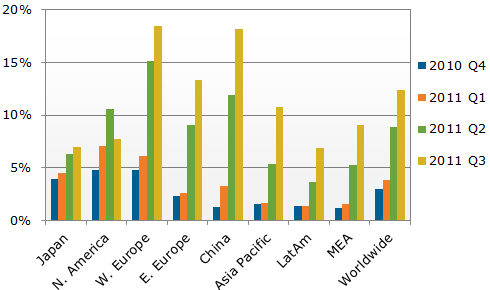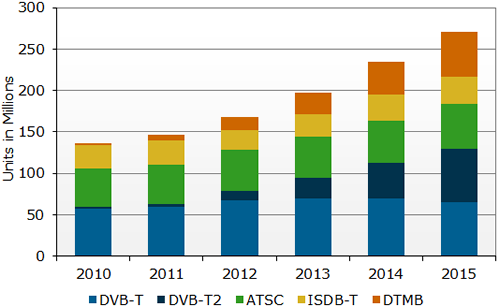DVB-T2 Enabled TV Shipments Forecast to Reach 64.7M in 2015
Wednesday, December 28th, 2011
3D TV Gaining Momentum in Western Europe and China, Declining in North America
SANTA CLARA, Calif. — Consumer behavior and TV set maker strategies are resulting in widely diverging TV product ranges across the world. While the industry is truly global, regional differences are increasing. For 3D, the most enthusiastic regions are Western Europe and China, while the mix of 3D in North America actually declined in Q3’11, according to the Q4’11 NPD DisplaySearch Quarterly TV Design and Features Report.
Figure 1: 3D Penetration as a Percentage of TVs Shipped

Source: NPD DisplaySearch Quarterly TV Design and Features Report
“We were surprised to find that 3D appears to be a far more popular feature in China than North America, and the penetration rate was two times higher in the last quarter,” said Paul Gray, Director of TV Electronics Research, NPD DisplaySearch. “Our report also indicates that North American and Japanese 3D penetration is lower than the Middle East.”
The report finds that North American consumers favor large, inexpensive TV sets with fewer features, unlike other regions. Chinese consumers are enthusiastic about richly-featured sets with 3D, LED backlighting and smart TV capabilities.
The report also examines the growth of smart TV in different regions and reveals that there are several emerging markets where fixed broadband appears to be leapfrogged by consumers. In Saudi Arabia, Poland, the Philippines and Indonesia, there are 10 to 15 times as many 3G subscribers as broadband. These consumers still want to view internet video on their TVs, but the usage is totally different in developed markets where the TV is connected directly to a wired broadband line.
This theme of simultaneous new technology adoption is also clear in digital broadcasting. While developed markets have not only introduced digital terrestrial and largely completed analog switch-off, a second generation of digital broadcast (DVB-T2) is now being adopted in Europe, the Middle East and Asia.
The report uniquely forecasts the prospects for DVB-T2 reception in TV. It finds that a critical mass of countries have now adopted or committed to DVB-T2. Shipments of DVB-T2-enabled sets are expected to grow from 3.4 million in 2011 to 64.7 million in 2015.
“By 2015 the number of DVB-T and DVB-T2 sets shipped will be equal,” added Gray. “The decision by the Russian and Indian governments to move to T2 has given the industry a huge boost in confidence, and it will kick-start a virtuous cycle of rapid adoption and cost reduction.”
The report finds the new digital transmission technology is not only being introduced in mature markets like the UK and Sweden, but also in Nigeria and Kenya.
Figure 2: TV Shipment Forecast by Digital Decoding Types

Source: NPD DisplaySearch Quarterly TV Design and Features Report
The NPD DisplaySearch Quarterly TV Design and Features Report is a quarterly update of the issues and rapid shifts in TV feature developments. The 250+ page report examines and forecasts video processor and signal processing IC market development, including 120/100 and 200/240 Hz frame rates as well as market shares for major IC vendors. In addition, the report also features forecasting for MPEG-4 decoding and the digital broadcast environment around the world, including forecasts for the following technologies: DVB-T2; TV connectivity, such as wired and wireless networked TVs; LED backlighting; 3D-capability and implementation; remote controls and chassis design; and power consumption.
For more information on this report, please contact Charles Camaroto at 1.888.436.7673 or 1.516.625.2452, or contact@displaysearch.com or contact your regional DisplaySearch office in China, Japan, Korea or Taiwan.
Latest News
- Netflix posts first quarter 2024 results and outlook
- Graham Media Group selects Bitmovin Playback
- Dialog, Axiata Group, Bharti Airtel agree on merger in Sri Lanka
- Yahoo brings identity solutions to CTV
- Plex has largest FAST line-up with 1,112 channels
- TV3 migrates from on-prem servers to AWS Cloud with Redge